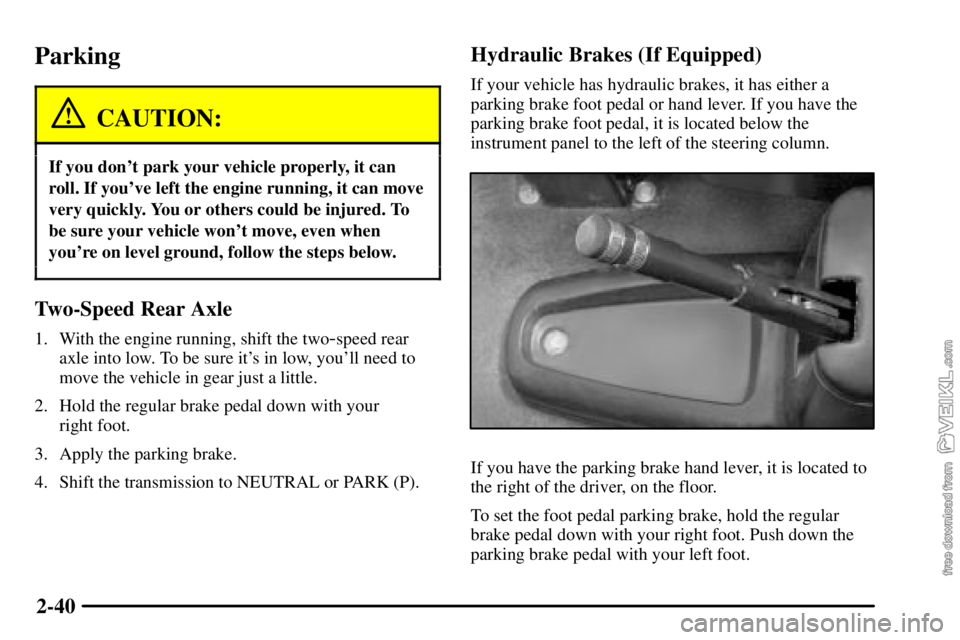Page 109 of 386

2-34 Rear Air Suspension Dump Control
If your vehicle is equipped with the Hendrickson HAS
Series single
-axle air suspension, you have this control.
The air suspension dump control allows the operator to
lower the deck height approximately 4.5 inches
(11.5 cm) from the normal frame height.
The switch to deflate and
inflate the air suspension is
located in the instrument
panel switchbank.
Press the bottom of the switch to deflate the air
suspension and lower the deck height. Press the top
of the switch to return the suspension to normal
deck height.
An indicator light will come on and stay on whenever
the switch is in the dumped position.
Automatic Transmission Operation
We build vehicles with five and six-speed automatic
transmissions. This part of the manual covers the basics
of these. With some of the transmissions, you will find
another manual in your vehicle that goes into more
detail. On the headliner, in front of and above the driver,
or in some other place near the driver, you will see a
label that describes important operating facts about the
automatic transmission in your vehicle. Make sure you
follow the instructions on this label.
Be sure to keep your parking brake set until you are
ready to shift into DRIVE (D), and press the brake pedal
while shifting from NEUTRAL (N) or PARK (P) to a
drive gear.
All vehicles equipped with automatic transmissions
can be started in PARK (P), if equipped, or in
NEUTRAL (N). See the Allison
� Transmission
Operator's Manual in your vehicle for more information
about this.
Page 111 of 386

2-36 Overdrive Defeat (If Equipped)
If your vehicle has this feature, you can select not to
shift up to fifth gear. This is useful when towing or
under a heavy load.
The overdrive defeat switch
is located in the instrument
panel to the right of the
steering column.
Press the switch to limit the transmission to fourth gear.
This will allow for better fuel economy and fewer
downshifts while pulling a tractor or trailer or under a
heavy load. The indicator light in the switch will come
on whenever overdrive defeat is active.
Manual Transmission Operation
Using the Clutch
When you're starting to move the vehicle, it's important
to begin with the engine speed at idle. Then start to
engage the clutch and listen for an engine speed drop
of about 100 rpm. At this point, the clutch is engaging,
so you should increase the engine speed and fully
engage the clutch. It's important not to increase the
engine speed sooner or before the clutch begins it's
engagement. If you do, you can cause damage to
your vehicle.
Double-Clutching
You must use the double-clutching method when you
shift an unsynchronized gear set. Disengage the clutch,
shift to neutral and engage the clutch. When upshifting,
slow the engine until the engine rpm and road speed
match. When downshifting, accelerate the engine until
the engine rpm and road speed match. Then quickly
disengage the clutch and move the shift lever to the next
gear position and engage the clutch.
Page 115 of 386

2-40
Parking
CAUTION:
If you don't park your vehicle properly, it can
roll. If you've left the engine running, it can move
very quickly. You or others could be injured. To
be sure your vehicle won't move, even when
you're on level ground, follow the steps below.
Two-Speed Rear Axle
1. With the engine running, shift the two-speed rear
axle into low. To be sure it's in low, you'll need to
move the vehicle in gear just a little.
2. Hold the regular brake pedal down with your
right foot.
3. Apply the parking brake.
4. Shift the transmission to NEUTRAL or PARK (P).
Hydraulic Brakes (If Equipped)
If your vehicle has hydraulic brakes, it has either a
parking brake foot pedal or hand lever. If you have the
parking brake foot pedal, it is located below the
instrument panel to the left of the steering column.
If you have the parking brake hand lever, it is located to
the right of the driver, on the floor.
To set the foot pedal parking brake, hold the regular
brake pedal down with your right foot. Push down the
parking brake pedal with your left foot.
Page 117 of 386
2-42 Air Brake (If Equipped)
CAUTION:
When the yellow SYSTEM PARK and the red
TRAILER AIR SUPPLY knobs are both pushed
in, your rig will be free to move. It could strike
someone or something. When both of these knobs
are pushed in, hold the regular brake pedal down
to keep your rig from moving.
If your vehicle has air
brakes, you will have this
parking brake. It is located
above the radio in the
instrument panel.
Pulling it out applies the parking brake. The park brake
light will come on when the air parking brake is applied.
Page 124 of 386

2-49 Turn and Lane-Change Signals
The turn signal has two upward (for right) and two
downward (for left) positions. These positions allow you
to signal a turn or a lane change.
To signal a turn, move the lever all the way up or down.
When the turn is finished, the lever will return
automatically.
An arrow on the instrument
panel cluster will flash in
the direction of the turn or
lane change.
To signal a lane change, just raise or lower the lever
until the arrow starts to flash. Hold it there until you
complete your lane change. The lever will return by
itself when you release it.As you signal a turn or a lane change, if the arrows don't
flash but just stay on, check the turn signal flasher and
circuit breaker. See ªFuses and Circuit Breakersº in
the Index.
If a bulb is burned out, replace it to help avoid an
accident. If the arrows don't go on at all when you
signal a turn, check the circuit breaker and for
burned
-out bulbs. (See ªFuses and Circuit Breakersº
in the Index.)
Headlamp High/Low-Beam Changer
To change the headlamps from low to high beam or high
to low beam, pull the multifunction lever all the way
toward you, then release it.
When the high beams are
on, this light on the
instrument panel cluster
will also be on.
Page 130 of 386
2-55
Inter-Axle Differential Lock Control
(If Equipped)
If your vehicle has this
feature, the switch is located
in the center of the
instrument panel.
If you're approaching a slippery surface where it looks
like one or even all of the wheels may start to slip, you
can press the bottom of this switch. It locks your rear
differentials so that power is transmitted equally to both
rear axles.Let up on the accelerator before you turn on your
inter
-axle differential lock. When you turn on this
control, the diff lock indicator on the center of the
instrument panel will light.
NOTICE:
Activating the inter-axle differential lock when
the rear wheels are actually spinning freely, as
they might on ice or snow, can cause you to lose
control of the vehicle. It can also damage the
axles. Turn on this control only when the wheels
are not spinning freely.
Page 131 of 386
2-56
Rear Axle Differential Lock Control
(If Equipped)
If your vehicle has a
controlled traction or
locking differential axle,
the switch is located in the
center of the instrument
panel. You'll see this
control on single rear
axle vehicles.If you're approaching a slippery surface where it looks
like one or even both wheels may start to slip, you can
press the bottom of this switch. It locks your rear
differential so that power is transmitted equally to both
rear wheels.
Let up on the accelerator before you turn on your rear
axle differential lock.
NOTICE:
Activating the rear-axle differential lock when
the rear wheels are actually spinning freely, as
they might on ice or snow, can cause you to lose
control of the vehicle. It can also damage the axle.
Turn on this control only when the wheels are not
spinning freely.
Page 133 of 386

2-58
The exterior lamp control has four positions:
OFF: Turning the control to this position turns off all
lamps except the Daytime Running Lamps (DRL).
(Parking Lamps): Turning the control to this
position turns on the parking lamps, together with the
following:
�Marker Lamps
�Taillamps
�License Plate Lamps
�Instrument Panel Lights
(Headlamps): Turning the control to this position
turns on the headlamps, together with the previously
listed lamps and lights.
You can switch your headlamps from low to high
beam by pulling the turn signal/multifunction lever
toward you. Pull the lever toward you again to return
to low beam.
A circuit breaker protects your headlamps. If you have
an electrical overload, your headlamps will flicker on
and off. Have your headlamp wiring checked right away
if this ever happens.
Headlamps On Reminder (If Equipped)
If you have this system, a tone will sound when your
headlamps and/or parking lamps are turned on and your
ignition is in LOCK or ACCESSORY.
Daytime Running Lamps
Daytime Running Lamps (DRL) can make it easier for
others to see the front of your vehicle during the day.
DRL can be helpful in many different driving
conditions, but they can be especially helpful in the
short periods after dawn and before sunset. Fully
functional daytime running lamps are required on all
vehicles first sold in Canada.
The DRL system will make your headlamps come
on at reduced brightness when the following conditions
are met:
�The ignition is on,
�the exterior lamp control is off, and
�the parking brake is released.
When the DRL are on, only your headlamps will be on.
The taillamps, sidemarker and other lamps won't be on.
Your instrument panel won't be lit up either.